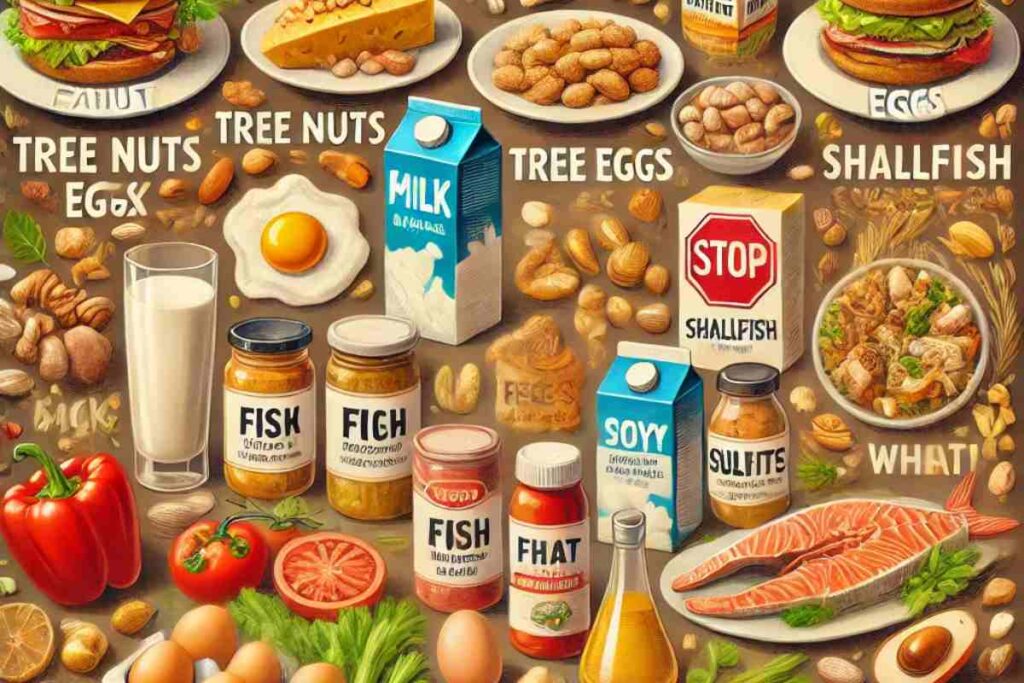14 Food Allergens: Food allergies are a serious health problem affecting millions in the UK and worldwide. For those who suffer from them, even the smallest amount of the allergen can cause a reaction reaching from mild discomfort to life-threatening anaphylaxis. That’s why individuals, food service workers and businesses need to understand which foods are most likely to cause allergic reactions and, more importantly, where these ingredients may be hiding.
The UK Food Information Regulations list 14 specific allergens that must be declared when used as ingredients. These allergens can be present in many products, often where you least expect them.
Whether you’re a consumer looking to protect yourself or a business looking to comply with regulations, knowing the main allergens and how they typically disguise themselves is critical to allergy prevention. Let’s take a look at each one.
1.Celery
Celery allergies can be severe, with stalks and seeds causing reactions. It is found in fresh produce and spice mixes, bouillon cubes, soups, and meat products. Another common culprit is celery salt, which is often used in condiments and salad dressings.
This allergen may be found in pre-packaged foods or prepared meals, so always read the ingredient list carefully. Restaurants may also use celery in bases such as mirepoix or as part of marinades and sauces.
2.Cereals Containing Gluten
Gluten is a protein in wheat, rye, barleycorn, and oats. It is a known contributor to celiac disease and gluten allergy. These grains are found in bread, pasta, cakes, cookies, and less obvious foods like soy sauce, beer, sauces, and some sweets.
Many processed foods contain gluten as a thickener or filler. Cross-contact is a problem, especially in shared kitchens or bakeries, so people with gluten sensitivity need to be vigilant.
3.Crustaceans
Crustaceans include crabs, shrimp, and lobster. Reactions to these shellfish can be severe, and the allergen can linger on utensils or surfaces. Crustaceans are common in Asian cuisine, seafood sauces, and fish broths.
Always check the labels on mixed seafood, sushi, and shrimp. Even a small amount from a shared fryer can be dangerous for allergy sufferers.
4.Eggs
Eggs are widely used in sweet and savory dishes, from cakes and mayonnaise to pasta and quiches. They can be challenging, especially in baked goods and processed foods.
Egg whites can also be found in less obvious places, such as wine (used for clarification), marshmallows, and some vaccines. People with egg allergies should always check the ingredients.
5.Fish
Even the smallest amount of protein can trigger fish allergies, and fish is often used in unexpected situations. Familiar hiding places include salad dressings (such as Caesar dressing), Worcestershire sauce, and broths.
Surimi (imitation crab), anchovy paste, and fish oil used in supplements or fortified foods can also cause reactions. Always check the ingredients, especially in prepared foods or sauces.
6.Lupin
Lupin is a legume related to peanuts that is increasingly used in gluten-free, protein-rich baked goods. It is found in flour, pastries, and bread, mainly those imported from Europe.
Its similarity to peanuts means that people allergic to one may react to the other. Because lupin is still relatively unknown, many people don’t expect to encounter it, making information and labeling even more critical.
7.Milk
Milk allergy differs from lactose intolerance and involves an immune response to milk proteins. Dairy products are found in many foods, including chocolate, baked goods, sauces, soups, and processed meats.
Milk derivatives like whey and casein may be found in protein powders, plant-based creamers, or flavors. Vegan or plant-based does not always mean dairy-free, so it is essential to check carefully.
8.Molluscs
Shellfish include mussels, oysters, and squid. They are common in seafood dishes, but their extracts can also be found in sauces, fish stews, and some supplements or cosmetics.
As with shellfish, cross-contact in the kitchen is a serious issue. Even suspended particles during cooking can cause reactions in people with hypersensitivity.
9.Mustard
Mustard is a common allergen in the UK and can be found in sauces, dressings, marinades, meat products and spice mixes. It comes in different forms: powder, seeds, oil and paste, all of which can cause allergies.
Be careful with mustard in prepared salads (such as coleslaw or potato salad), chutneys and curries. Some products may simply be listed under ‘spice.’
10.Nuts (Tree Nuts)
Nuts include almonds, cashews, walnuts, hazelnuts, and pecans. They are commonly found in desserts, cereals, sauces, nut jars of butter, and snacks.
Traces of nuts may also be found in foods made in shared spaces, so people with allergies should be wary of products labeled “may contain.” Other hidden sources include flours and nut extracts, such as almond flour or hazelnut flavoring.
11.Peanuts
Peanut allergy is one of the most common and potentially life-threatening allergies. Peanuts are added to spreads, sweets, sauces (such as satay) and baked goods.
Look out for peanut-derived ingredients such as peanut butter (especially unrefined), peanut flour or peanuts. They may also be present in less obvious foods such as curries or protein bars.
12.Sesame Seeds
Sesame is often added to baked goods such as hamburger buns, cookies, and breadsticks. It is also used in Middle Eastern and Asian dishes, especially as tahini, an ingredient in hummus.
Sesame oils, pastes, and hidden seeds in processed foods can cause reactions. Some breads contain ground sesame flour, making it even more difficult to detect visually.
13.Soya
Soy is widely used in processed foods, not just in tofu or soy sauce, but also in baked goods, meat substitutes, soups, chocolate, and even baby formula. It’s a very versatile ingredient and hard to avoid.
Soy lecithin is a common emulsifier in chocolate, dressings, and packaged foods. People with soy allergies should be cautious with plant-based products.
14.Sulphur Dioxide (Sulphites)
Sulfites are preservatives in dried fruits, wine, beer, vinegar, and processed meats such as sausages. They can cause respiratory reactions and other symptoms, especially in people with asthma.
Foods such as pre-cut potatoes, frozen seafood, and fruit juices may also contain sulfites to preserve color and freshness. Even small amounts must be listed on the label if they exceed a certain level.
Don’t Just Read Labels — Learn the Risks Behind Them
The presence of these 14 allergens is not always prominent and can be hidden in flavors, additives, or processing methods. It is not enough to simply read a label: consumers and food workers must be aware of allergens and understand how they are used in different cuisines and products.
Proper knowledge and monitoring are vital in managing your allergies or helping someone else. By raising allergy awareness, carefully reading ingredient lists, asking the right questions, and following strict food handling procedures, we can create a safer environment for everyone. The more you know, the more protected you will be and the safer you feel in any restaurant.


